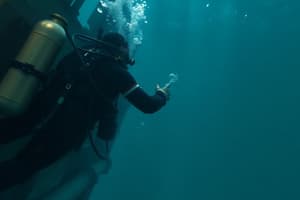Podcast
Questions and Answers
In the electrical incident described, what was a key procedural failure that directly contributed to the arc flash?
In the electrical incident described, what was a key procedural failure that directly contributed to the arc flash?
- The permit to work was in place, but the communication of the tasks was not clear.
- The electrician used a fuse insertion tool with an inadequate voltage rating.
- The electrician re-installing the fuses failed to verify the isolation of the drive cabinet before commencing work. (correct)
- The vessel's SOP adequately addressed long-term isolations for multiple personnel.
In the 'Fall from Height' incident, what was the primary factor that led to the crew member's fall?
In the 'Fall from Height' incident, what was the primary factor that led to the crew member's fall?
- There were adequate communications between the deck personnel.
- The control of work and permit systems were correctly implemented.
- The crew member was not wearing a safety harness.
- The crew member lacked awareness of the ongoing SIMOPS and did not check for changes in the work area. (correct)
In the incident where a worker suffered serious injuries involving a conveyor belt, what critical safety measure was omitted, leading to the injury?
In the incident where a worker suffered serious injuries involving a conveyor belt, what critical safety measure was omitted, leading to the injury?
- The site supervisor was distracted and failed to complete the Permit to Work and isolation. (correct)
- The conveyor belt was properly isolated before the worker began repairs.
- The site supervisor completed the Permit to Work form.
- The Permit to Work and isolation procedures were correctly carried out.
What modification was implemented to improve safety while handling the metal plate?
What modification was implemented to improve safety while handling the metal plate?
According to the UK HSE report regarding the LPG leak, what was a key systemic failure that contributed to the incident?
According to the UK HSE report regarding the LPG leak, what was a key systemic failure that contributed to the incident?
Flashcards
What is Permit To Work (PTW)?
What is Permit To Work (PTW)?
A formal documented system used to control, communicate, and coordinate potentially hazardous activities during a specific task or operation.
What are SIMOPS (Simultaneous Operations)?
What are SIMOPS (Simultaneous Operations)?
Hazards introduced when multiple operations occur simultaneously in the same area, increasing risk due to interaction between tasks.
What is Energy Isolation?
What is Energy Isolation?
A process to neutralize energy sources to protect workers. Includes verifying isolation before work begins.
What is Dynamic Risk Assessment?
What is Dynamic Risk Assessment?
Signup and view all the flashcards
What is 'Safety by Design'?
What is 'Safety by Design'?
Signup and view all the flashcards
Study Notes
- IMCA Safety Flashes summarize key safety matters and incidents to facilitate learning and prevent recurrence.
- The effectiveness of the system relies on members sharing anonymized/sanitized information.
Permit to Work and Isolation Procedure
- An electrician installed fuses on a live 930V DC electrical system.
- The system powered under deck carousels and other vessel systems from the same drive cabinet.
- The electrical isolation was done by removing fuses for the carousel drive unit.
- The vessel was in port, and systems driven by the cabinet were not powered when fuses were initially removed.
- The electrician isolated the cabinet by isolating breakers and removing fuses, leaving the fuses at the bottom of the cabinet without tags and an unlocked cabinet.
- A second electrician re-installed fuses, believing the cabinet was isolated, which resulted in an arc flash and a blown fuse; no injury occurred.
- There was no Permit To Work (PTW) in place.
- The work team failed to understand and apply the required level of electrical work and isolation controls.
- The SOP for work on the equipment powered by the drive cabinet did not consider long-term isolations to protect multiple workers.
- Procedures were not followed regarding the security of the electrical cabinet as an electrician did not lock or tag the cabinet when the fuses were removed.
- Additional work team requirements for isolations discussed in the Toolbox Talk (TBT) were not carried out.
- The electrician re-installing fuses failed to verify the drive cabinet was isolated before starting work, which is contrary to instructions.
- Review procedures, work instructions, task risk assessments for Permit to Work and electrical isolations.
- Review Toolbox Talks to ensure they cover all aspects of the work including PTW and isolations.
- Ensure the system to work on is isolated BEFORE starting work; Follow workplace instructions and warning signs.
LTI - Fall from Height (control of work during SIMOPS)
- The Marine Safety Forum published Safety Alert 21-18 about a fall from the bridge deck to the deck below.
- A team working on the monkey island went to the bridge level after finishing work.
- A team member removed his safety harness and spotted a paint drip needing attention.
- While dealing with said paint drip, and working backwards in a restricted space, he fell 3m through an unguarded opening left by the lifted grating to the boat deck.
- Control of Work and Permit to Work Systems were either implemented incorrectly or were not implemented at all.
- There was a lack of situational awareness, risk perception, awareness of SIMOPS, and communication between deck personnel.
- No barriers or signage was present in the area, and a fall hazard was introduced by removing bridge gantry gratings.
- Implement more thorough toolbox talks and pre-task risk assessments.
- Identify combined operations and additional hazards introduced by SIMOPS to determine if it can be avoided or executed at different times and assess the risk level.
- Keep records to prevent recurrence and input changes into the Permit to Work/Control of Work process.
UK HSE: Poor Control of Work - Serious Injuries
- A supervisor was sentenced for safety breaches after a worker became entangled in a conveyor belt, which resulted in serious injury to his hand and arm.
- A damaged conveyor belt needed repair.
- The worker began repair work before the supervisor completed the Permit to Work or isolated the line.
- The supervisor was distracted by another matter, leading to an incomplete Permit to Work, which allowed the conveyor belt to restart during repair work.
- The supervisor failed to implement company policy and procedure for Permits to Work and isolation.
Fractured Finger When Handling Metal Plates
- A crew member suffered a pinch injury to their right hand baby finger as a result of working on deck and fractured the tip of the finger and required sutures.
- Heavy weather damaged welded plates.
- In the process of manually repositioning the plate with another crew member, the injured person sustained a pinch injury to their finger when it was trapped between the plate and frame
- An X-ray confirmed a distal fracture that required stitches.
- The plate design did not allow for safe manual handling.
- The plate installation had a permanent risk of finger entrapment.
- Risk assessments and toolbox talks used were generic, not task specific, focusing on hot work and not including manual handling.
- The plate was modified to have temporary handles to keep fingers away from the pinch points.
- Sourcing magnetic lifting handles is a long term solution.
- Ensure that generic risk assessments are modified for the task with either a dynamic risk assessment or toolbox talk for a full assessment of risk.
- To improve the process and make it safer, use the toolbox talk or JSA to improve the task by defining and understanding risks and reducing the probability and/or severity.
UK HSE: Liquid Petroleum Gas (LPG) Leak
- The UK Health and Safety Executive (HSE) reported that a fine was issued to the operator of the UK's largest oil refinery for health and safety breaches involving a liquid petroleum gas (LPG) leak.
- Approximately 15 tonnes of LPG were released through a valve near a roadway at a refinery in Fawley, Hants, UK.
- The leak went undetected for around four hours and was discovered by an employee cycling home.
- It took over an hour to find the leak source, and on-site emergency personnel had to reset the valve.
- LPG was put through the pipe work at too high a pressure for the valve.
- There was no process in place to detect the discrepancy in the flow in the pipe.
- The company failed to take all measures necessary to prevent a major incident.
- Measures to prevent incidents should be proportionate to the risks where companies are required to have layers of protection in place to prevent incidents with large quantities of substances.
- Layers of protection failed or were not in place, resulting in a significant leak, where there was no fire or injury, there was potential for a major incident.
- Emphasis has been brought to light to highlight the importance of maintaining the layers of protection and preventing leaks like the one that occurred.
Studying That Suits You
Use AI to generate personalized quizzes and flashcards to suit your learning preferences.




